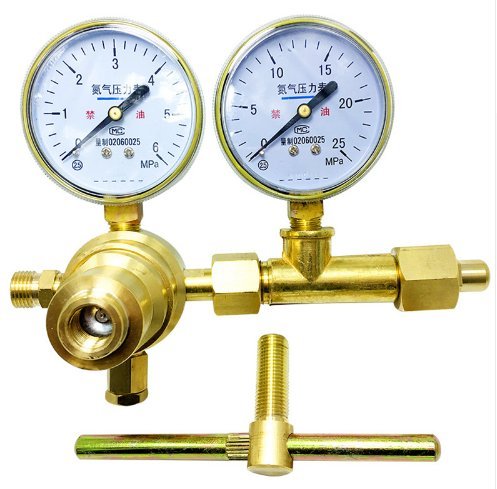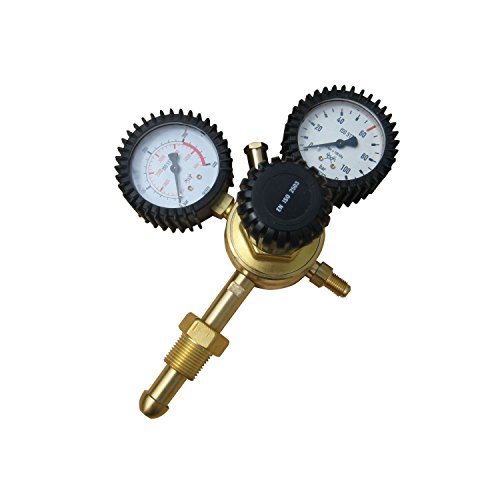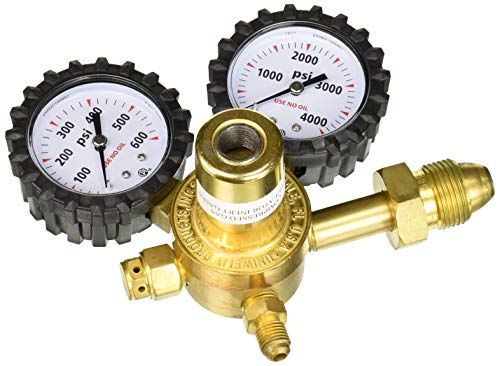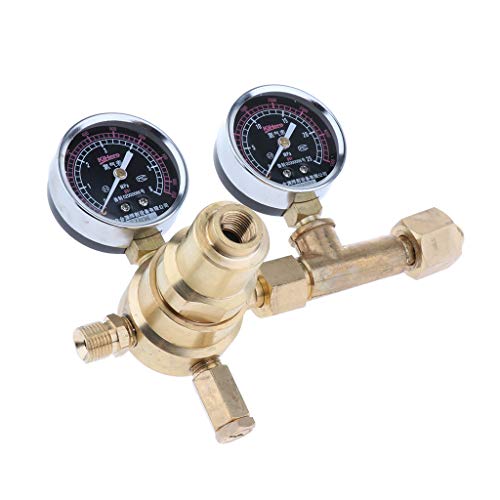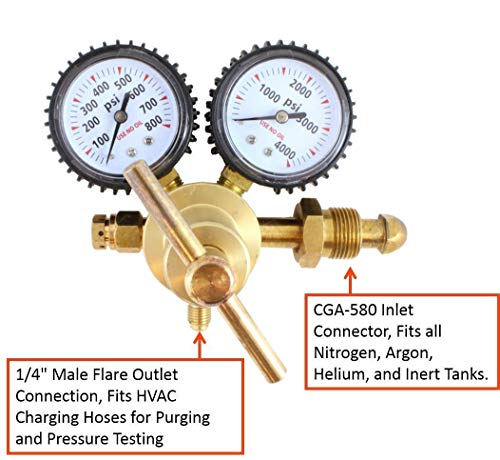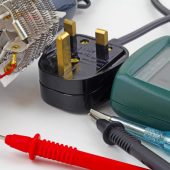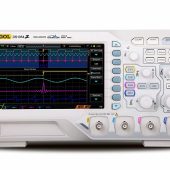Nitrogen regulators reduce the pressure of gas from a pressurized tank, allowing for a controlled flow. This allows the user to vary outflow pressure for different applications and ensures safe use.
Nitrogen gas regulators are typically used with oxygen-free nitrogen tanks but some can also be used with argon and some other gasses.
Always check what gasses you can use the regulator with. Look up the manufacturer’s specifications or check if there’s a CGA number inscribed on the regulator above the threading.
Nitrogen gas regulators are used in a wide range of industries. Wherever there are nitrogen cylinders, a nitrogen regulator is essential to maintain the correct and safest flow and pressure.
Applications include brazing, laboratories, chemical plants, tire inflation, pharmaceuticals and mining.
In this buying guide, we review the best nitrogen regulators. But first, here are a few things to keep in mind when shopping for a nitrogen regulator.
- Read also: Best paint thickness gauges
What To Look For When Buying A Nitrogen Regulator
1) Type of gas
It goes without saying that you should buy a regulator designed for use with nitrogen.
Some nitrogen-specific regulators can also be used with other gasses like argon or oxygen (via an adapter) but check the product manual or ask the manufacturer before you do it.
Even if it is safe to use the regulator for another gas not specified by the manufacturer, the gauge readings will likely be inaccurate. That’s because the regulator is calibrated for a specific gas density.
This could lead to too much (wastage) or too little gas delivery.
2) Max pressure
This is the most important thing to check when buying a nitrogen regulator. It determines what applications you can use the regulator for.
Basic regulators have a pressure range between 0 and 400 psi. Mid-priced regulators can provide pressure as high as 600 psi while premium regulators go up to 800 psi and some can output pressure over 1,000 psi.
Minimum pressure is usually not important as most regulators start from zero. But it’s still a good idea to go through the manufacturer specifications to check if there’s a minimum pressure it can deliver.
3) Build quality
Build quality is important for safety. You don’t want a regulator that will snap off or start leaking when you are using it.
We recommend getting a regulator mostly made from stainless steel especially if you plan to use it in a rough work environment.
The diaphragm should also be made from stainless steel, which prevents galling (a form of wear).
Of course, not all parts are going to be stainless steel. The gauges and a few other components are usually made from plastic.
4) Single vs. Double stage
You’ll come across two types of regulators when shopping: single and double stage regulators.
Single-stage regulators regulate air pressure in a single stage. They are cheaper but have a higher margin of error since delivery pressure is not always consistent.
Two-stage regulators are actually two regulators in one. They regulate gas pressure in two stages.
The first stage has a factory-preset pressure that you cannot change. You can only adjust the second regulator.
2-stage nitrogen regulators offer higher precision and consistency in terms of delivery pressure. They maintain the delivery pressure even if the inlet pressure changes.
Two-stage regulators are ideal for high-pressure applications where it is essential to maintain delivery pressure within a very narrow margin.
5) Easy to read gauges
Don’t forget to check the gauges. There are typically two of them: one shows the cylinder pressure and the other indicates the delivery pressure.
You can adjust the delivery pressure within a certain range – e.g. 0-400 psi or 0-800 psi – depending on your job requirements.
The gauges should have easy-to-read scales with large numbers and gradations. Most gauges offer readings in two scales: psi and bar. Others may also use mpa.
6) Easy pressure adjustment
Look for a nitrogen regulator with a T-handle or any other kind of handle that is easy to turn even with thick gloves on.
This makes it easy to adjust delivery pressure to your needs.
Best Nitrogen Regulator Reviews
1. High Pressure YQD-370 Nitrogen Regulator
The YQD-370 is ideal for applications that require high delivery pressure. You can adjust the delivery pressure between 1 and 6 mpa. It accepts input pressure between 0 and 25 mpa.
The regulator is made from copper and contains a filter to prevent debris from getting into the regulator.
The two gauges are large and easy to see from a distance. Both the inlet and outlet scales indicate pressure readings in mpa.
Each gauge is covered in scratch-resistant clear plastic to maintain good visibility through years of use.
2. Oxyturbo Nitrogen Regulator
The Oxyturbo nitrogen regulator provides a delivery pressure up to 60 bars (870 psi) and accepts inlet pressure up to 300 bar.
The max flow rate is 150 m3/h.
It works with oxygen-free nitrogen as well as argon.
This regulator is ideal for use in rough environments. The solid brass design ensures strength and durability.
Even the gauges are made from metal – rather than the usual plastic – with protective boots to protect them from knocks and falls.
A grooved knob makes it easy to adjust delivery pressure even when you are wearing gloves.
The Oxyturbo nitrogen regulator comes with two outlet adaptors – 1/4″ SAE and 5/16″SAE – for use with different connections.
3. Protech 87-RHP400 Nitrogen/CO2 Regulator
The Protech 87-RHP400 works with both nitrogen and CO2. Like the Oxyturbo regulator, this one works great in the roughest of environments whether it’s welding or roofing.
The external housing is made from steel. For added reliability and durability, it uses a piston-actuated seat.
The two gauges are protected by rubber boots and covered with a durable and scratch-resistant polycarbonate lens.
The outlet pressure gauge goes all the way to 600 psi. However, the selectable delivery pressure range is 20 to 400 psi. The regulator comes with a T-handle for easy adjustment.
As for inlet pressure, the Protech 87-RHP400 accepts up to 4,000 psi from the cylinder.
The two scales are large enough for easy viewing even from a distance. The high black on white contrast improves visibility in different light conditions.
The regulator comes with a 1/4″ SAE male outlet connection.
4. Homyl Solid Brass Nitrogen Regulator
This is another good choice for anyone looking for a high-pressure nitrogen regulator.
The max input pressure is 25mpa (around 3,500 psi) while the max selectable delivery pressure is 6mpa (870 psi).
Adjusting output pressure is easy with the adjustment knob.
The regulator body is made from brass to ensure durability especially in rough work environments like welding.
The gauges are pretty big with a white on black print styling that improves contrast and visibility.
Both gauges provide readings in mpa and psi. The psi scale is red for easy differentiation.
5. HUKOER Nitrogen Regulator
The HUKOER nitrogen regulator has a CGA-580 connector that can be used with nitrogen, helium, argon and other inert gas cylinders.
The 1/4-inch male flare outlet is compatible with various connections including HVAC hoses for purging.
The max delivery pressure is 600 psi and the minimum is 20 psi. The regulator accepts a max inlet pressure of 4,000 psi.
You can see the pressure readings clearly on the large 2” gauges to ensure you don’t exceed the set parameters.
Built quality is great. The body is made from brass, ensuring years of reliability. The gauges are protected by rubber boots to protect them from accidental knocks and falls.
The regulator comes with a large T-handle that makes it easy and quick to adjust delivery pressure.

